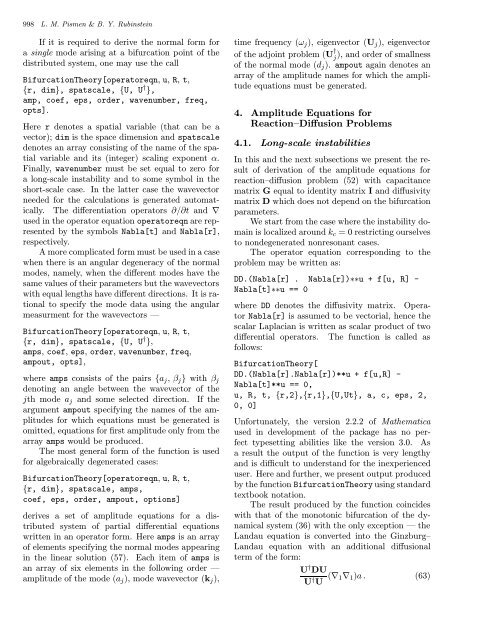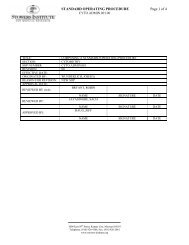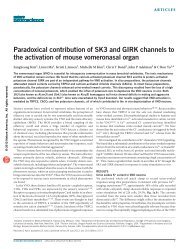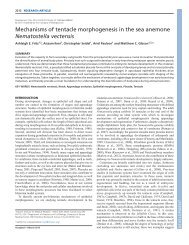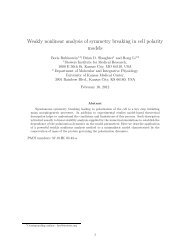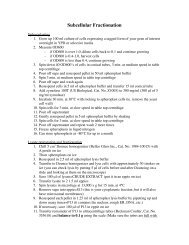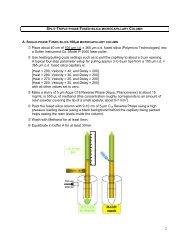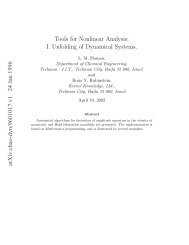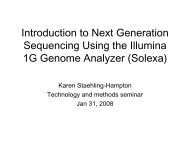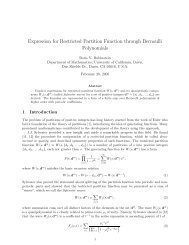Computer Tools for Bifurcation Analysis: General Approach with
Computer Tools for Bifurcation Analysis: General Approach with
Computer Tools for Bifurcation Analysis: General Approach with
You also want an ePaper? Increase the reach of your titles
YUMPU automatically turns print PDFs into web optimized ePapers that Google loves.
998 L. M. Pismen & B. Y. Rubinstein<br />
If it is required to derive the normal <strong>for</strong>m <strong>for</strong><br />
a single mode arising at a bifurcation point of the<br />
distributed system, one may use the call<br />
<strong>Bifurcation</strong>Theory[operatoreqn, u, R, t,<br />
{r, dim}, spatscale, {U, U † },<br />
amp, coef, eps, order, wavenumber, freq,<br />
opts].<br />
Here r denotes a spatial variable (that can be a<br />
vector); dim is the space dimension and spatscale<br />
denotes an array consisting of the name of the spatial<br />
variable and its (integer) scaling exponent α.<br />
Finally, wavenumber must be set equal to zero <strong>for</strong><br />
a long-scale instability and to some symbol in the<br />
short-scale case. In the latter case the wavevector<br />
needed <strong>for</strong> the calculations is generated automatically.<br />
The differentiation operators ∂/∂t and ∇<br />
used in the operator equation operatoreqn are represented<br />
by the symbols Nabla[t] and Nabla[r],<br />
respectively.<br />
A more complicated <strong>for</strong>m must be used in a case<br />
when there is an angular degeneracy of the normal<br />
modes, namely, when the different modes have the<br />
same values of their parameters but the wavevectors<br />
<strong>with</strong> equal lengths have different directions. It is rational<br />
to specify the mode data using the angular<br />
measurment <strong>for</strong> the wavevectors —<br />
<strong>Bifurcation</strong>Theory[operatoreqn, u, R, t,<br />
{r, dim}, spatscale, {U, U † },<br />
amps, coef, eps, order, wavenumber, freq,<br />
ampout, opts],<br />
where amps consists of the pairs {a j ,β j }<strong>with</strong> β j<br />
denoting an angle between the wavevector of the<br />
jth mode a j and some selected direction. If the<br />
argument ampout specifying the names of the amplitudes<br />
<strong>for</strong> which equations must be generated is<br />
omitted, equations <strong>for</strong> first amplitude only from the<br />
array amps would be produced.<br />
The most general <strong>for</strong>m of the function is used<br />
<strong>for</strong> algebraically degenerated cases:<br />
<strong>Bifurcation</strong>Theory[operatoreqn, u, R, t,<br />
{r, dim}, spatscale, amps,<br />
coef, eps, order, ampout, options]<br />
derives a set of amplitude equations <strong>for</strong> a distributed<br />
system of partial differential equations<br />
writteninanoperator<strong>for</strong>m.Hereamps is an array<br />
of elements specifying the normal modes appearing<br />
in the linear solution (57). Each item of amps is<br />
an array of six elements in the following order —<br />
amplitude of the mode (a j ), mode wavevector (k j ),<br />
time frequency (ω j ), eigenvector (U j ), eigenvector<br />
of the adjoint problem (U † j ),andorderofsmallness<br />
of the normal mode (d j ). ampout again denotes an<br />
array of the amplitude names <strong>for</strong> which the amplitude<br />
equations must be generated.<br />
4. Amplitude Equations <strong>for</strong><br />
Reaction–Diffusion Problems<br />
4.1. Long-scale instabilities<br />
In this and the next subsections we present the result<br />
of derivation of the amplitude equations <strong>for</strong><br />
reaction–diffusion problem (52) <strong>with</strong> capacitance<br />
matrix G equal to identity matrix I and diffusivity<br />
matrix D which does not depend on the bifurcation<br />
parameters.<br />
We start from the case where the instability domain<br />
is localized around k c = 0 restricting ourselves<br />
to nondegenerated nonresonant cases.<br />
The operator equation corresponding to the<br />
problem may be written as:<br />
DD.(Nabla[r] . Nabla[r])∗∗u + f[u, R] -<br />
Nabla[t]∗∗u == 0<br />
where DD denotes the diffusivity matrix. Operator<br />
Nabla[r] is assumed to be vectorial, hence the<br />
scalar Laplacian is written as scalar product of two<br />
differential operators. The function is called as<br />
follows:<br />
<strong>Bifurcation</strong>Theory[<br />
DD.(Nabla[r].Nabla[r])**u + f[u,R] -<br />
Nabla[t]**u == 0,<br />
u, R, t, {r,2},{r,1},{U,Ut}, a, c, eps, 2,<br />
0, 0]<br />
Un<strong>for</strong>tunately, the version 2.2.2 of Mathematica<br />
used in development of the package has no perfect<br />
typesetting abilities like the version 3.0. As<br />
a result the output of the function is very lengthy<br />
and is difficult to understand <strong>for</strong> the inexperienced<br />
user. Here and further, we present output produced<br />
by the function <strong>Bifurcation</strong>Theory using standard<br />
textbook notation.<br />
The result produced by the function coincides<br />
<strong>with</strong> that of the monotonic bifurcation of the dynamical<br />
system (36) <strong>with</strong> the only exception — the<br />
Landau equation is converted into the Ginzburg–<br />
Landau equation <strong>with</strong> an additional diffusional<br />
term of the <strong>for</strong>m:<br />
U † DU<br />
U † U (∇ 1∇ 1 )a. (63)


